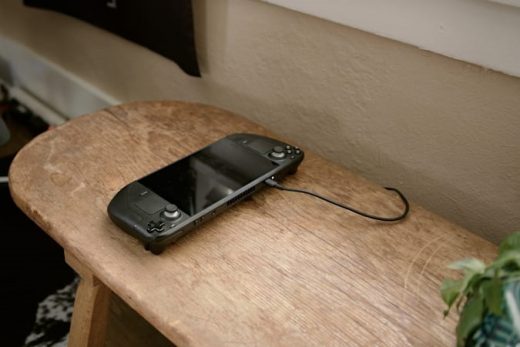iFixit will sell replacement parts for almost every Steam Deck component
Valve Steam Deck review: Just portable enough
Folks with tiny hands, this is the review for you.

A lot of people are going to compare the Steam Deck to the Switch, and that’s totally fair, but after spending more than a week with Valve’s portable PC, I think there’s a better analogy at hand: The Steam Deck is what happens when the Vita and the Wii U get drunk on Linux and make a big baby together.
The Steam Deck combines Valve’s familiar PC storefront with some of the best ideas from these iconic, discontinued consoles, and packs all of it into a beefy bit of hardware. Just like Sony and Nintendo did all those years before, with the Steam Deck Valve is silently asking, does anyone need this?
Steam Deck
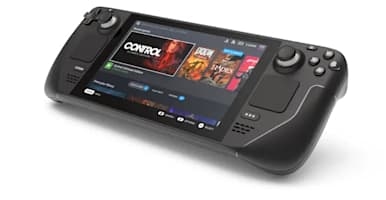
Pros
- Starts at $400
- Steam comes pre-installed
- Sturdy body
- Haptic trackpads are a nice touch
- Expandable storage
Cons
- Ridiculously large and heavy
- Incomplete Steam library support
- Bluetooth issues
- Sweaty Palm Syndrome
The short answer is, no. But you’re still gonna want one.
When I unboxed the Steam Deck and got a good look at Valve’s handheld PC for the very first time, I laughed. I couldn’t help it, but this thing is seriously so large it’s funny. The Steam Deck is 11.7 inches long, 4.6 inches tall and 1.9 inches thick, and it weighs 1.5 pounds. For comparison, the Switch Lite and Vita each weigh about half a pound, while the Wii U gamepad weighs just over 1 pound.
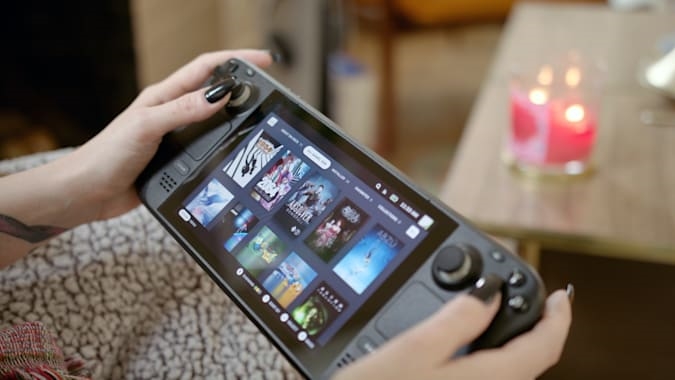
The Steam Deck’s heft affects how I interact with every game in my Steam library. I find myself holding the system low in my lap, often propping it up on my thighs and craning my neck down in order to play. After about an hour in this position, the muscles along the back of my head start to ache, and I’ve been calling this phenomenon Steam Deck neck. It’s easily remedied with some stretching and repositioning, but the Steam Deck always ends up back on my lap and the cycle of discomfort continues.
And then there’s the sheer size of the thing. Anyone with smaller-than-average hands, here’s where you need to listen up.
The Steam Deck is a full-size controller with a 7-inch LCD touchscreen in the middle; it has big, rounded grips, haptic trackpads on either side of the screen, and analog sticks and face buttons above those. Two bumpers line the top, with two triggers and four clickers on the back. At more than 4.5 inches tall, I’m unable to rest the Steam Deck on my palms while also reaching the top buttons with my thumbs, and even using the analog sticks is difficult in this position. I have to support the controller by clutching the grips about an inch above the bottom, straining my pinky fingers and encroaching on the back buttons in a way that renders them useless. It truly feels like my hands are too small for the Steam Deck.
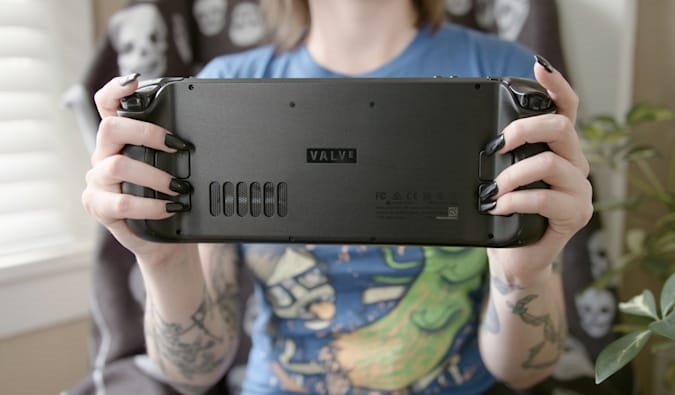
Each game uses a unique input method, and some titles cause more aching in my palms than others. Swapping rapidly among the right analog stick and face buttons, as in action games or shooters, tends to speed up my discomfort. But trackpad- and touchscreen-heavy games like Inscryption and World of Horror allow me to move my hands down or even just place the Steam Deck on a table, where I can tap away with my tiny fingers.
At the risk of narrowing my audience even more, I’d like to note that full-set manicures present a specific problem with the Steam Deck: The options tab is the perfect thumb-nail distance from the X button, and I’ve accidentally pressed it a handful of times while slaying demons in Devil May Cry 5. To all six of you who care, you’re welcome.
The ergonomics of the Steam Deck will vary with each user, and people with larger hands than mine will likely have a less crampy time. But I bet their palms will still get sweaty.
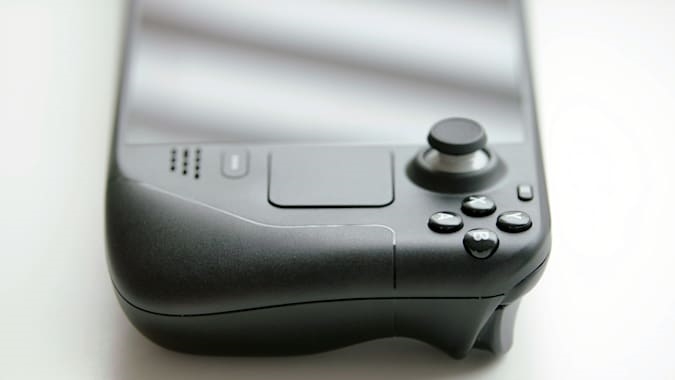
The Steam Deck runs hot, but it’s never scalding to the touch — instead, it feels like all that heat is dispersed throughout the device, including in the controller grips. After about 30 minutes of playing any game, my palms get warm enough to start sweating, in a way that’s never happened with a DualSense or Xbox controller. The first time this happened, I blamed it on the pile of blankets I was buried under, but sweaty palm syndrome is a consistent occurrence with the Steam Deck. Additionally, the system fan regularly blows hot air from the top of the machine and this makes a noticeable amount of noise, though it’s nothing extreme. Noisewise, you’ll be fine pulling this baby out on public transportation. Sizewise, that’s your call.
Because of the sweaty palms, finger cramps and Steam Deck Neck, my play sessions max out at two hours. This isn’t terrible in terms of actual playtime, and it means I’ve never run into a battery issue with the Steam Deck. Valve says the system will get two to eight hours of life on a single charge, depending on what games you’re playing and their settings. This aligns with my experience — Devil May Cry 5 definitely sucks more juice out of the battery than World of Horror, as does playing above 30 fps and 50 percent brightness. To that end, there’s an option to lock games at 30 fps and it’s possible to adjust screen brightness at any time.
This review is based on the mid-tier Steam Deck with 256GB of NVMe SSD storage, priced at $530. There’s also a 512GB model with a high-speed SSD and anti-glare etched glass that costs $650, and a 64GB version that’s just $400. Aside from offering a dismal amount of storage space, the 64GB model uses much slower eMMC storage, and I haven’t seen what that looks like in person.
All versions of the Steam Deck have the same AMD APU, which shares a lot of DNA with the chips inside the PS5 and Xbox Series consoles, along with 16GB of fast RAM, a 40Whr battery and a 7-inch 800p 60Hz display. SteamOS runs the whole damn thing and it takes up 30GB on my mid-tier model, leaving it with 227GB free — so keep that calculation in mind, too. There is a high-speed microSD slot so players can expand their libraries and even play games directly off a card, but internal storage is definitely faster than this method.
Now, the games. The Steam Deck is technically a handheld PC, which means it can theoretically support every game in Valve’s library, though this isn’t the case out of the box. Some Steam titles are officially optimized for the system, while some are not supported at all, and others are functioning on pure hope. There are four optimization levels — Verified, Playable, Unsupported and Untested — and so far, roughly 10 percent of my library falls in the Verified category. Valve rolled out a website where players can see how their games will fare on the Steam Deck, and across the board, the bulk of these titles are falling under the Untested category.
There is a workaround here, if you’re willing to put in the effort. The Steam Deck runs on a Linux-based operating system because that’s very much Valve’s thing, and this is the culprit behind the device’s compatibility issues. While some games run natively, the majority utilize Valve’s Proton compatibility layer to run Windows games. Proton has improved significantly over the years, but there are still a lot of issues, especially with online games that have aggressive anti-cheat solutions. If there’s a specific game you’re curious about, there are sites that collate user reports like ProtonDB which should give you an idea of how well something will run.
However, the Steam Deck is an open platform, and it’s possible to install Windows on the system and boot up Steam from there, with all the compatibility of a standard PC. This isn’t what the device was built to do, presenting a handful of UX concerns out of the gate, and more importantly, it’s not how the majority of owners are going to use the Steam Deck. For most players, it’ll be all about compatibility labels.
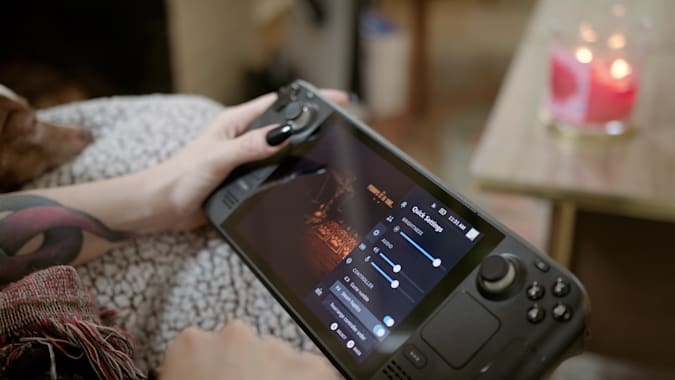
I haven’t had a game-breaking issue with any Verified game on Steam Deck, and at worst, I’ve had to spend a few seconds adjusting framerate and brightness settings. In my experience, games labeled Playable generally perform well, though they often require a second glance at the control layout. Playing Inscryption, I was stuck on a scene for a few minutes before realizing I simply had to pull up the on-screen keyboard, which is accessible in the Quick Settings overlay at any time. A prompt appears before installing Playable games outlining their known issues on Steam Deck, like small font or mouse-and-keyboard icons, and it’s easy to make a decision about installing from there.
When it comes to Untested games, you’re on your own. This is the Steam Deck’s wild west, and I’ve seen it all from titles in this category: Artful Escape won’t even load past the developer logo; BPM plays fine but it’s visually blown out; Kentucky Route Zero runs beautifully.
Figuring out how to unbreak a partially supported title on Steam Deck is a game in itself. My advice: If there’s a title you desperately want to play without interruption or frustration, then don’t play it on Steam Deck unless it’s Verified. You’ll likely just be annoyed and disappointed and probably a little sad.
This also might happen when trying to pair Bluetooth devices with the Steam Deck. This process has been hit-and-miss for me — my Xbox controllers refuse to connect to the Steam Deck (no, they weren’t paired with another device at the time) and my Samsung Galaxy Buds don’t even show up as available. However, my new Marshall Bluetooth speaker connects to the Steam Deck without fuss.

The device’s USB-C port makes it possible to hook up a hub and connect a mouse, keyboard, display and ethernet cable, though I didn’t try this out. The official Dock, which is designed just for this use case, won’t come out until late spring and I’ll give it a whirl then.
I tested a handful of familiar games on Steam Deck, including Hades, Celeste, Devil May Cry 5, Inscryption, Cuphead and World of Horror, and I wouldn’t say that it felt better to play any title on the handheld, rather than PC. However, the Steam Deck delivers something worthwhile: flexibility.
The Steam Deck allows me to step away from my desktop, where I spend all day working, and play my games somewhere I can fully relax. Sure, this is already possible through Steam Link, but the Steam Deck makes the process more luxurious. I’ve loved having one in the house, and truly, it couldn’t have come at a better time. I just moved and I don’t have a TV yet, so I haven’t been able to escape to my living room after work as usual. The Steam Deck has filled the void left vacant by my PS5 and Xbox Series S, allowing me to play on the couch at the end of the day — at least until my neck gets sore.
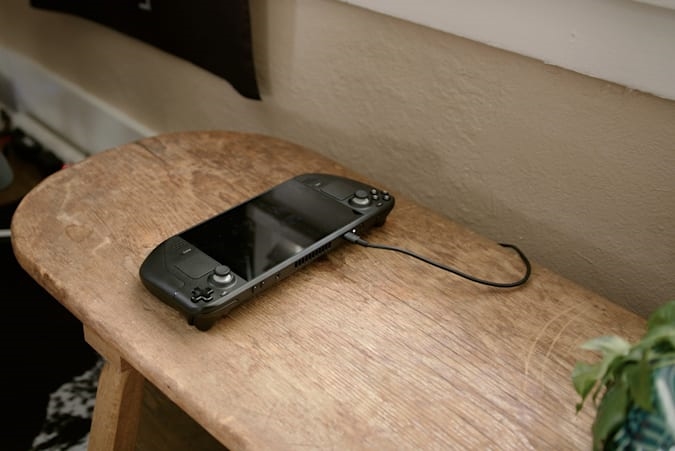
The Steam Deck’s battery life is less of an issue than I thought it would be, largely because the way I use the machine is different than I first imagined. Initially, I figured the Steam Deck would be more like a Switch Lite, something to throw in my bag and take out into the world, a truly mobile version of my Steam library. But in practice, I use the Steam Deck more like a Wii U — it stays at home and I play it on the couch after work or in bed at night, never far from its charger or a sensible tabletop to rest it on.
The Steam Deck is a Frankenstein synthesis of a Wii U and a Vita, but with Valve’s DNA coursing through its cables. It’s a Steam Controller and a Steam Machine in one hefty package, and I’ve come to appreciate it for what it does best. The Steam Deck isn’t a mobile device to take on your everyday commute; it’s a Steam library extender, opening up new places to play around the house. I wouldn’t recommend the Steam Deck as an introduction to PC gaming, but for millions of existing Steam users, it’s worth the price of entry, even if you just play a few times a month, two hours at a time.
(25)

